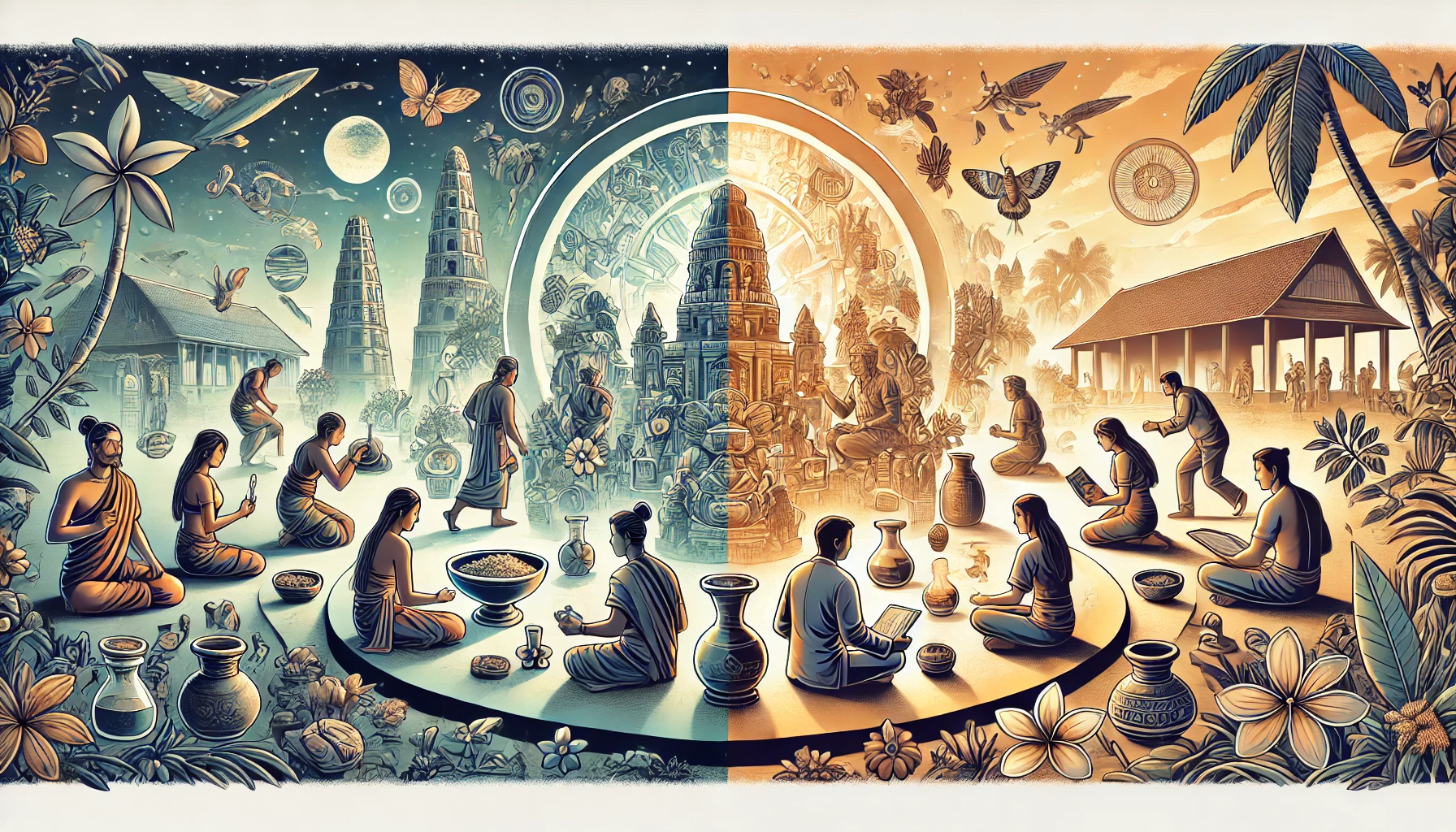1. Introduction
Kratom (Mitragyna speciosa) is a tropical tree native to Southeast Asia, whose leaves have played an important role in traditional medicine and cultural practices of the region for centuries. This plant, belonging to the Rubiaceae family, is known for its unique properties that have long attracted the attention of local inhabitants.
In the cultures of Southeast Asian countries such as Thailand, Malaysia, and Indonesia, kratom holds a special place. Its significance goes far beyond being a simple medicinal remedy – it is an integral part of the social fabric of society, an element of spiritual practices, and a symbol of the connection between humans and nature. Kratom leaves have been used not only to alleviate physical ailments but also as a tool for achieving altered states of consciousness necessary for various rituals and ceremonies.
2. Historical Roots of Kratom Use
The first mentions of kratom in historical sources date back several centuries. However, oral traditions and archaeological evidence suggest that the use of this plant could have begun much earlier, possibly in prehistoric times.
One of the earliest written records of kratom use can be found in the notes of Dutch colonizers who arrived in Southeast Asia in the 17th century. They described how local inhabitants chewed the plant’s leaves to increase their productivity and relieve pain.
The geographical spread of traditional kratom use was primarily limited to the regions where it naturally grows. This includes:
– Southern Thailand, particularly the provinces of Nakhon Si Thammarat, Phatthalung, and Satun
– Peninsular Malaysia
– Indonesian islands, particularly Kalimantan (Borneo) and Sumatra
– Certain regions of Myanmar (Burma) and Papua New Guinea
In each of these regions, unique traditions of kratom use developed, reflecting local culture and beliefs. For example, in Thailand, kratom was often associated with rural culture and was used by workers to increase endurance during long days in the fields.
Interestingly, despite the geographical proximity, kratom did not become widely used in some neighboring countries like Vietnam or Cambodia. This highlights the unique and localized nature of traditions associated with this plant.
As trade routes and cultural exchange developed, knowledge about kratom gradually spread beyond its original area, laying the foundation for its modern global distribution and interest in other parts of the world.
3. Kratom in Traditional Rituals
The use of kratom in traditional Southeast Asian rituals was multifaceted and deeply rooted in local culture. Let’s examine the main aspects of its application:
Religious Ceremonies:
In some animistic beliefs of the region, kratom was considered a sacred plant given by spirits. Shamans and spiritual leaders used it to achieve altered states of consciousness, allowing them to communicate with the spirits of ancestors and nature. In Thailand, for instance, kratom leaves were sometimes included in offerings to spirits during important ceremonies.
Social Rituals:
Kratom played an important role in the social life of communities. In Malaysia, there was a tradition of offering guests a drink made from kratom leaves as a sign of hospitality. In some Thai villages, the communal consumption of kratom was part of rituals that strengthened community bonds, especially among men.
Healing Practices:
Traditional healers used kratom in various healing rituals. It was used to treat diarrhea, cough, diabetes, and pain relief. In some communities, there were complex rituals for preparing medicinal mixtures with kratom, accompanied by prayers and incantations.
4. Symbolic Meaning of Kratom in Various Cultures
Kratom as a Symbol of Endurance and Strength:
In cultures where kratom was traditionally used, it often symbolized endurance and strength. Plantation and field workers chewed kratom leaves to cope with hard physical labor, leading to the plant being associated with diligence and resilience. In some Thai communities, there was a saying: “Strong as a kratom chewer.”
Spiritual Aspects of Kratom Use:
In spiritual practices, kratom symbolized the connection between the physical and spiritual worlds. Shamans believed that the plant opened the “doors of perception,” allowing them to interact with the spiritual realm. In some animistic beliefs in Indonesia, kratom was considered the embodiment of the spirit of wisdom and healing.
In Malay culture, kratom was sometimes associated with the concept of “semangat” – the life force or soul. It was believed that consuming kratom could enhance a person’s “semangat,” making them more resilient to life’s challenges.
Interestingly, in some communities, kratom had dual symbolism. On one hand, it symbolized strength and endurance; on the other, moderation and self-control, as excessive use was seen as a sign of weak character.
In the modern context, the symbolic meaning of kratom continues to evolve. For some, it has become a symbol of traditional wisdom and a connection to roots, while for others, it symbolizes the contradictions between traditional practices and modern legislation.
These rich cultural associations and symbolic meanings of kratom underscore its importance not only as a plant with certain properties but also as an integral part of the cultural heritage of Southeast Asian peoples.
5. Methods of Preparation and Consumption in Ancient Rituals
Traditional Methods of Harvesting and Processing Leaves:
In ancient cultures, the harvesting of kratom leaves was surrounded by rituals and beliefs. It was thought that the best time for harvesting was early morning when the dew had not yet dried. Typically, the leaves were collected by senior community members or specially designated individuals who knew the correct prayers and offerings to the plant spirits.
After harvesting, the leaves were usually sun-dried, sometimes pre-crushed. In some regions, the leaves were fermented by burying them in the ground for several days, which was believed to enhance their properties.
Ritual Drinks and Mixtures:
- “Kratom Tea”: The most common method. Dried leaves were brewed with hot water, often adding honey or lemon for flavor.
- “Chewing Balls”: Fresh leaves were chewed, sometimes mixed with betel and lime.
- “Ritual Paste”: Leaves were ground with water to a paste, which was used for body application during certain ceremonies.
- “Smoke Rituals”: In some shamanic practices, kratom leaves were burned, and the smoke was used for space purification or in healing purposes.
6. Evolution of Kratom Use: From Ancient to Modern Times
Changes in the perception and use of kratom over time have been significant:
- From Ritual to Everyday: Initially used predominantly for ritualistic purposes, kratom gradually became part of daily life, especially among the working class.
- Medical Application: Traditional medicinal uses of kratom caught the attention of modern medicine, leading to scientific research on its properties.
- Recreational Use: In some societies, kratom began to be used as an alternative to alcohol or other mind-altering substances.
- Global Spread: With the development of international trade, kratom extended beyond its traditional area, becoming known in many countries worldwide.
Impact of Colonization and Globalization on Traditional Practices:
The colonial period significantly influenced the perception and use of kratom:
- Bans and Restrictions: Colonial authorities often viewed traditional practices as “backward” or “dangerous,” leading to restrictions on kratom use in some regions.
- Scientific Interest: European researchers began studying kratom’s properties, leading to its inclusion in the pharmacopeias of some countries.
- Cultural Exchange: Globalization facilitated the spread of information about kratom, leading to its popularization beyond traditional usage regions.
- Commercialization: Traditional ritual use of kratom in many places gave way to commercial production and distribution.
- Legislative Changes: Different countries adopted various laws regulating kratom use, affecting traditional practices.
These changes have resulted in today’s perception and use of kratom being quite different from ancient times. However, some communities in Southeast Asia still preserve elements of traditional ritual use of this plant.
7. Modern Neotraditional Practices
Use of Kratom in New Spiritual Movements:
In recent decades, kratom has found its place in various neotraditional and new spiritual practices:
- Neoshamanism: Some Western neoshamanism practices have incorporated kratom into their rituals, often combining it with meditation or other techniques for altered states of consciousness.
- Psychonautics: Experimenters in the field of consciousness expansion use kratom as a tool for self-exploration and spiritual growth.
- Alternative Medicine: Kratom has become part of holistic health approaches, where it is used to treat chronic pain, anxiety, and depression.
- Yoga and Meditation: Some practitioners use small doses of kratom to deepen meditative states or improve concentration during yoga.
Adaptation of Ancient Rituals to Modern Context:
Traditional practices of kratom use have been adapted to modern realities:
- Kratom Ceremonies: Some eco-communities and retreat centers hold ceremonies inspired by traditional kratom use, adapted for a modern audience.
- Microdosing: The practice of taking small doses of kratom regularly to enhance productivity and creativity.
- Digital Rituals: Online communities create virtual spaces for sharing experiences and conducting “digital ceremonies” with kratom.
- Art Therapy: Some artists and musicians integrate kratom into their creative practices, producing works under its influence.
8. Controversies and Debates
Cultural Appropriation vs. Intercultural Exchange:
The use of kratom outside its traditional context sparks debates:
- Cultural Appropriation Arguments: Critics argue that Western use of kratom without understanding its cultural significance is a form of
exploitation.
- Intercultural Exchange Perspective: Proponents speak of mutual cultural enrichment and the dissemination of ancient wisdom.
- Authenticity Questions: Debates on how closely modern practices align with traditional rituals.
- Economic Aspects: Discussions on the impact of global demand for kratom on local communities in Southeast Asia.
Legality and Ethics of Modern Ritual Practices:
Using kratom for ritual purposes faces legal and ethical challenges:
- Legal Status: Kratom’s legal status varies across countries, affecting its ritual use.
- Religious Freedom: Debates about the right to use kratom in religious and spiritual practices in countries where it is banned.
- Safety and Responsibility: Questions on ensuring safe use of kratom in ritual contexts.
- Ethics of Spread: Debates on the ethics of popularizing kratom beyond traditional cultures, especially given the risk of addiction.
- Preservation of Traditions: Discussions on how to preserve authentic ritual practices amid globalization and commercialization.
These controversies and debates reflect the complexity of integrating traditional practices into the modern global context, highlighting the need for a respectful and mindful approach to cultural heritage.
9. Scientific Perspective on Traditional Kratom Use
Research by Ethnobotanists and Anthropologists:
The scientific community shows significant interest in traditional kratom use:
- Ethnobotanical Studies: Scientists study various kratom strains used in traditional practices and their specific properties.
- Anthropological Observations: Researchers document rituals and customs associated with kratom in various Southeast Asian cultures.
- Linguistic Studies: Analysis of local names and terminology related to kratom helps understand its cultural significance.
Potential Medical Applications Based on Traditional Use:
Traditional kratom use has inspired numerous modern medical studies:
- Pain Relief: Researching kratom alkaloids to develop new analgesics.
- Addiction Treatment: Exploring kratom’s potential in opioid addiction therapy based on traditional practices.
- Antidepressant Effects: Studying kratom’s impact on mood and its potential in treating depression.
- Anti-inflammatory Properties: Investigating traditional use of kratom for treating various inflammatory conditions.
10. Conclusion
Significance of Preserving Cultural Heritage:
Traditional use of kratom represents an important part of the cultural heritage of Southeast Asia. Preserving this knowledge and practices is essential not only for understanding the region’s history and culture but also for potential contributions to modern science and medicine.
Balancing Tradition and Modernity in Kratom Use:
As kratom becomes more known worldwide, it is important to balance respecting traditional practices and adapting to modern realities. This includes:
- Supporting Research: Encouraging studies that explore traditional kratom use and its potential modern applications.
- Developing Ethical Guidelines: Creating guidelines for kratom use that consider its cultural significance.
- Promoting Dialogue: Facilitating dialogue between traditional practices and modern science for mutual enrichment of knowledge.
In our store, Viva Dzen, we offer a wide range of kratom, paying tribute to its rich cultural history. We strive to provide our customers not only with quality products but also with information about its traditional use and cultural significance.
By purchasing kratom from Viva Dzen, you not only get a product but also become part of a centuries-old tradition. We invite you to explore our assortment and learn more about each type of kratom, its origin, and traditional use.
Remember that using kratom requires a responsible approach and respect for its cultural heritage. We are always ready to answer your questions and provide additional information about the cultural context and proper use of kratom.






